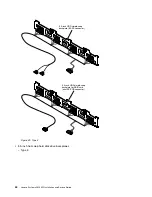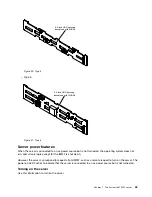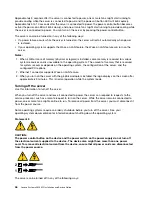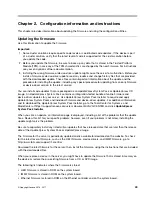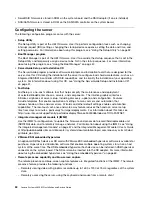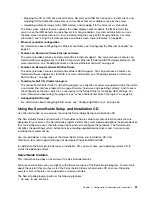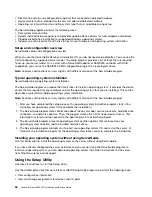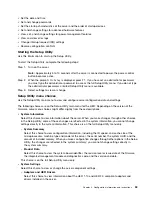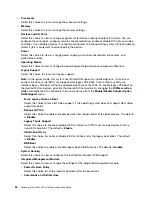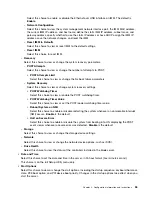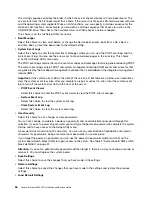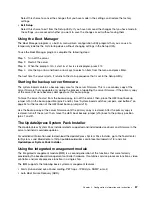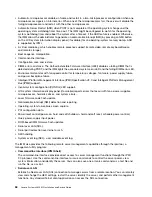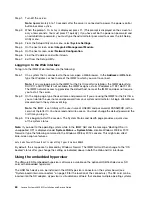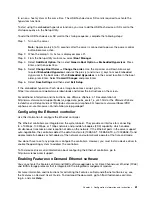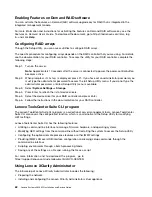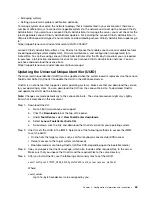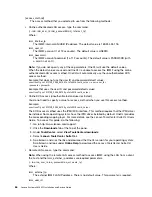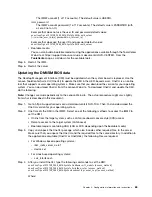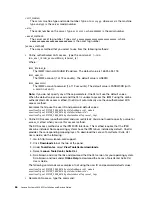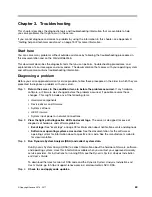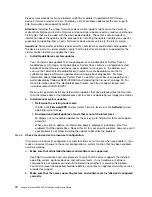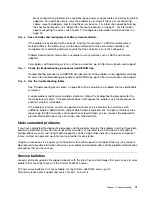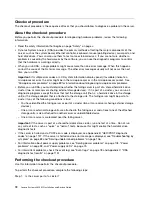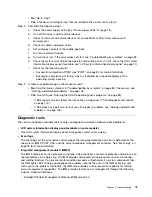
• Automatic microprocessor disable on failure and restart in a two-microprocessor configuration when one
microprocessor signals an internal error. When one of the microprocessors fail, the server will disable the
failing microprocessor and restart with the other microprocessor.
• Automatic Server Restart (ASR) when POST is not complete or the operating system hangs and the
operating system watchdog timer times-out. The IMM might be configured to watch for the operating
system watchdog timer and reboot the system after a timeout, if the ASR feature is enabled. Otherwise,
the IMM allows the administrator to generate a nonmaskable interrupt (NMI) by pressing an NMI button
on the LCD system information display panel (if available) for an operating-system memory dump. ASR
is supported by IPMI.
• A virtual media key, which enables remote presence support (remote video, remote keyboard/mouse,
and remote storage).
• Boot sequence manipulation.
• Command-line interface.
• Configuration save and restore.
• DIMM error assistance. The Unified Extensible Firmware Interface (UEFI) disables a failing DIMM that is
detected during POST, and the IMM lights the associated system error LED and the failing DIMM error LED.
• Environmental monitor with fan speed control for temperature, voltages, fan failure, power supply failure,
and power backplane failure.
• Intelligent Platform Management Interface (IPMI) Specification V2.0 and Intelligent Platform Management
Bus (IPMB) support.
• Invalid system configuration (CONFIG) LED support.
• LCD system information display panel (if available) reports errors that occur with fans, power supplies,
microprocessor, hard disk drives, and system errors.
• Local firmware code flash update
• Nonmaskable interrupt (NMI) detection and reporting.
• Operating-system failure blue screen capture.
• PCI configuration data.
• Power/reset control (power-on, hard and soft shutdown, hard and soft reset, schedule power control).
• Query power-supply input power.
• ROM-based IMM firmware flash updates.
• Serial over LAN (SOL).
• Serial port redirection over telnet or ssh.
• SMI handling
• System event log (SEL) - user readable event log.
The IMM also provides the following remote server management capabilities through the ipmitool, a
management utility program:
•
Command-line interface (IPMI Shell)
The command-line interface provides direct access to server management functions through the IPMI
2.0 protocol. Use the command-line interface to issue commands to control the server power, view
system information, and identify the server. You can also save one or more commands as a text file and
run the file as a script.
•
Serial over LAN
Establish a Serial over LAN (SOL) connection to manage servers from a remote location. You can remotely
view and change the UEFI settings, restart the server, identify the server, and perform other management
functions. Any standard Telnet client application can access the SOL connection.
58
Lenovo System x3650 M5 Installation and Service Guide
Summary of Contents for x3650 M5
Page 1: ...Lenovo System x3650 M5 Installation and Service Guide Machine Type 8871 ...
Page 47: ...Figure 35 System board switches jumpers and buttons Chapter 1 The System x3650 M5 server 35 ...
Page 60: ...48 Lenovo System x3650 M5 Installation and Service Guide ...
Page 80: ...68 Lenovo System x3650 M5 Installation and Service Guide ...
Page 124: ...112 Lenovo System x3650 M5 Installation and Service Guide ...
Page 146: ...134 Lenovo System x3650 M5 Installation and Service Guide ...
Page 1322: ...1310 Lenovo System x3650 M5 Installation and Service Guide ...
Page 1330: ...Taiwan BSMI RoHS declaration 1318 Lenovo System x3650 M5 Installation and Service Guide ...
Page 1339: ......
Page 1340: ......

